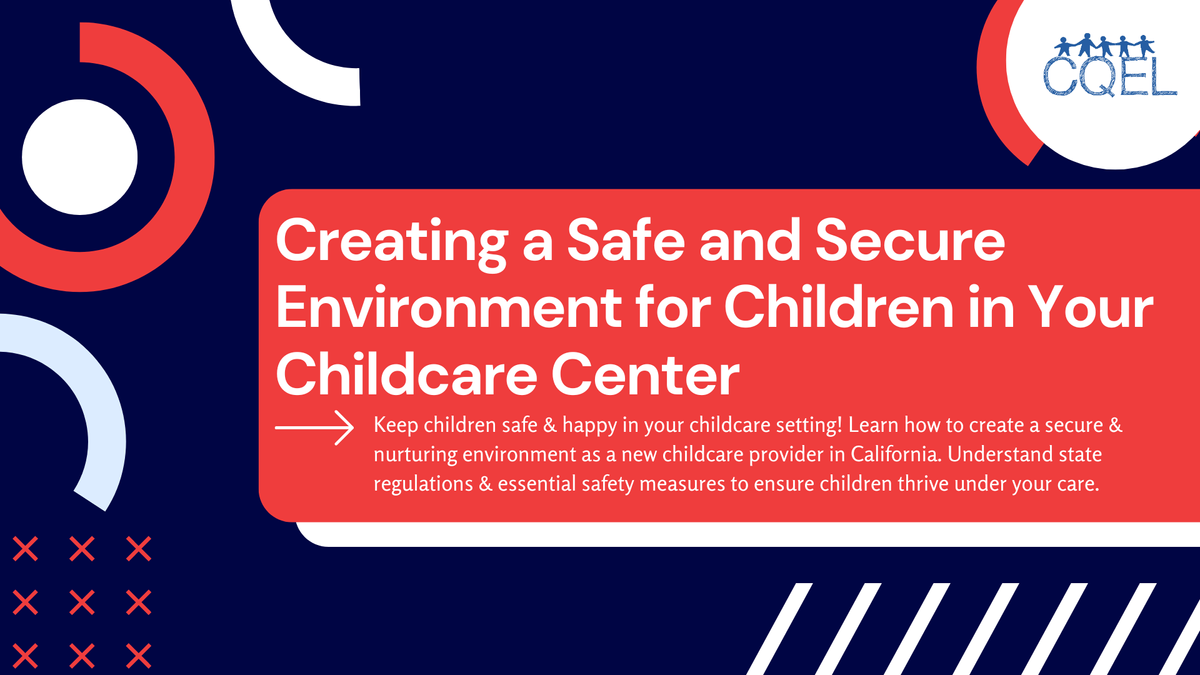Creating a Safe and Secure Environment for Children in Your Childcare Center
Keep children safe & happy in your childcare setting! Learn how to create a secure & nurturing environment as a new childcare provider in California. Understand state regulations & essential safety measures to ensure children thrive under your care.

Ensure the safety and well-being of children is paramount in childcare settings. As an aspiring childcare provider, you shoulder a critical responsibility in creating a secure and nurturing environment where children can thrive. State regulations, which establish safety standards for childcare facilities, further emphasize this responsibility. Understanding these regulations and implementing effective safety measures is crucial for any aspiring childcare provider.
Essential safety measures encompass various aspects of your childcare environment. Maintaining a clean and hazard-free facility is fundamental. This includes regularly inspecting electrical outlets for damage, ensuring playground equipment is in good repair, and providing age-appropriate toys free from choking hazards. Detailed guidance on these aspects can be found in the Child Care Licensing Regulations. These regulations serve as a comprehensive resource and should be consulted for specific requirements.
Another critical element of a safe environment is adequate adult supervision at all times. State regulations typically establish adult-to-child ratio requirements to ensure proper supervision. Beyond ratios, qualified staff with training in child development and safety procedures are essential. Many states offer training programs on topics like CPR and first aid; equipping your staff with these skills can be lifesaving in emergency situations.
Emergencies, while hopefully rare, require a well-defined plan to ensure the safety of children and staff. Develop a comprehensive emergency plan that outlines procedures for fire drills, evacuation in various scenarios, and first-aid protocols. Include clear communication plans for contacting parents and emergency responders. Several resources are available to assist you in developing a comprehensive emergency plan; consult your state licensing agency or childcare associations for recommendations.
Protecting children from abuse and neglect is another vital aspect of safety. Familiarize yourself with the signs and symptoms of child abuse and neglect. Many states, like California, have mandatory reporting requirements for suspected cases of abuse. Training programs on child abuse prevention are available and can equip you with the knowledge and skills to recognize and report suspected abuse.
Building a culture of safety goes beyond regulations and checklists. Open communication with parents and staff is critical. Encourage parents to voice safety concerns and actively listen to their feedback. Regularly discuss safety procedures with staff and encourage them to report any potential hazards.
Establishing clear safety routines and expectations for children is essential. Regular handwashing after using the bathroom or before eating is a simple yet crucial safety routine. Playground rules, like taking turns on equipment and using equipment safely, should be clearly communicated and consistently enforced. Adapt your approach based on the children's age; utilize songs, pictures, or interactive activities to teach safety rules in a way that is engaging and age-appropriate.
Regular safety assessments are a proactive way to identify and address potential hazards before they cause harm. Conduct regular inspections of your facility and equipment, paying close attention to playgrounds, toys, and electrical outlets. Maintain documentation of these inspections and any corrective actions taken.
Creating a safe and secure environment for children is a continuous process that requires dedication and vigilance. By adhering to state regulations, implementing effective safety measures, and fostering a culture of safety, you can create a nurturing environment where children can learn, play, and grow with confidence. Remember, ongoing education and refining your safety practices demonstrate your commitment to providing the best possible care for the children entrusted to you.
Additional Resources:
- Child Care Licensing Regulations: https://www.cdss.ca.gov/inforesources/child-care-licensing/resources-for-providers/laws-and-regulationsEnsure the safety and well-being of children is paramount in childcare settings. As an aspiring childcare provider, you shoulder a critical responsibility in creating a secure and nurturing environment where children can thrive. State regulations, which establish safety standards for childcare facilities, further emphasize this responsibility.
- National Child Abuse Hotline: https://www.childhelp.org/hotline/: 1-800-422-4453
